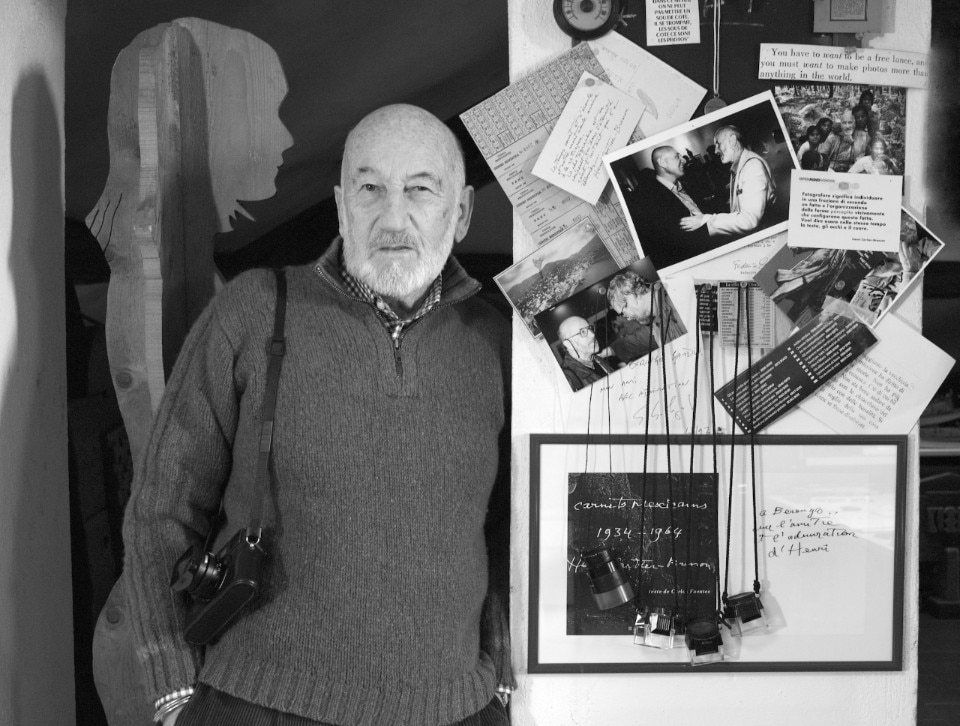“I’m not a columnist, I’m a photographer. And as a photographer I see today’s Italy, which is better in some ways than before, while as far as people go it’s got a lot worse. A lot.” There’s something lyrical about Gianni Berengo Gardin, a quality that makes him much more than a photographer. Just as Robert Capa and Henri Cartier-Bresson were. And this Venetian, born by chance at Santa Margherita Ligure, closely resembles them.
Charisma. Approach. Culture. Humility. There could be many explanations for all this. But perhaps the truest is that what really interests this young man who has just turned ninety, the only subject, the favoured focus of his pictures, is Italian society. Its changes, its inner turmoil, its light and above all the shadows of that particular relationship that society casts on the landscape. Berengo remains one of the twentieth-century masters of this vision, though he has travelled to every corner of the world in the last half century and accumulated an immense archive, a small part of which can now be seen in a retrospective presented by the Olivetti Historical Archives.
“Gianni Berengo Gardin and Olivetti”, the exhibition curated by Margherita Naim and Giangavino Pazzola, again shows his interest in Italian society. It investigates 70 period photos, in which the intensity of the relationship between Berengo and Olivetti in Ivrea becomes an existential metaphor. It was a professional relationship, but one that was heightened and developed in two directions essential to understanding his artistic identity. One is more aesthetic and formal, exploring the value of the design of industrial and residential architecture. The other is more inward and substantial, embodying in images the social system of relationships inside and outside the factory built by Adriano. “Working for Olivetti was an outstanding experience. Adriano was gone, but all his people were still there in the various sectors. Unique people, who nurtured my values because they influenced me deeply.” Berengo particularly remembers the evenings, after the photoshoots. “The days were incredible, but the evenings were beyond everything. We would get back to the hotel worn out, but then our spirits revived because we all got together over dinner and started chatting. I came to know incredible people for a young hopeful like me – writers, intellectuals, painters, engineers, philosophers. They stayed with us and treated us as one of them. Apart from the pleasure of the work and the money, which was generous, to me the most important part about working for Olivetti were the human and cultural qualities.”
This is one reason why Berengo feels baffled by today’s world, where the evolution of society has been matched by changes in photography. “I never imagined photography would become this. I don’t know how to describe it. Digital has made some things better, but most have changed for the worse. Let me be clear, I’m not against digital. It was obviously a great revolution. Technically, the model I tried out actually has the rendering of a view camera, but I feel digital is still too metallic, too cold, all things I don’t look for in photography. I feel that film is far more tactile and above all it produces a negative. I see having a negative, something concrete you can hold in your hand, as a big advantage. With digital we don’t know whether in 50 years’ time there’ll still be the instruments to read our photos or the media will have completely changed again and everything will be lost. In principle I can say I’m not against digital, but I don’t think the medium has great advantages. And then post-production, whatever they say, is really expensive. So, as I see it, digital has been a revolution and, as in all revolutions, there’s good and bad, so it shouldn’t become an ideology that will sweep everything else away. At the same time, reportage has disappeared. Because when everyone takes pictures with their mobile phones and the newspapers don’t look at the quality and want the photos to be given away, how can you do reportage? This is how young people go in for photography, which they think is an art, though it isn’t.” Berengo sees the future of photography in specialisation. Fashion, advertising, even architecture. But no longer that special lyrical quality of reportage. And about the future of society, Berengo is even less optimistic.
“I don’t know why it’s gotten worse. But I do know that our generation after the war was used to sacrifices, to going without. And no one complained, we never complained. Young people today complain about everything, they always want more and don’t know that they’re leading a life no one ever had before them. So I haven’t the faintest idea what’s going to happen. Of course, if we go on like this, with young people spending their evenings at cafés squandering passions and talents, wasting precious time, not understanding who they are or making a commitment, there isn’t cause for optimism.”
One of Italy’s greatest photographers, Berengo Gardin has almost 2 million black-and-white photos in his archive, ranging from social investigations to industrial spaces, architecture to landscape. His new show, “Gianni Berengo Gardin e la Olivetti”, is open until 15 November at Camera, Turin.
Opening image: Gianni Berengo Gardin. Photo Donatella Pollini


